Taiwan
- A Glance at Taiwan Statistics

Location Asia Area 36,000 square kilometers Population 23 million Capital Taipei City President Mr. Ma Ying-jeou - The Beautiful Island – “Formosa”
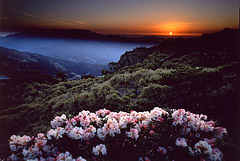 Formosa is what the Portuguese called Taiwan when they came here in the 16th century and saw the verdant beauty of the island.
Formosa is what the Portuguese called Taiwan when they came here in the 16th century and saw the verdant beauty of the island.
Taiwan is situated in the East Asia about 160 kilometers (100 miles) from the southern coast of the Chinese mainland. Located about midway between Korea and Japan to the north and Hong Kong and the Philippines to the south, Taiwan is a natural gateway for travelers to and within Asia.
Shaped roughly like a sweet potato, Taiwan is 394 kilometers (245 miles) long and 144 kilometers (89.5 miles) wide at its broadest point. The Central Mountain Range bisects Taiwan from north to south and about two-thirds of the island is covered with forested peaks. The rest of the island is made up of foothills, terraced flatlands, and coastal plains and basins.
Taiwan lies on the western edge of the Pacific "rim of fire," and continuous tectonic movements have created majestic peaks, rolling hills and plains, basins, coastlines, and other natural landscapes. Taiwan's tropical, sub-tropical, and temperate climates provide clear differentiation between the different seasons. There are about 18,400 species of wildlife on the island, with more than 20% being rare or endangered species. Among these are the land-locked salmon, Taiwan serow, Formosan rock monkey, Formosan black bear, blue magpie, Mikado pheasant, and Xueshan grass lizard.
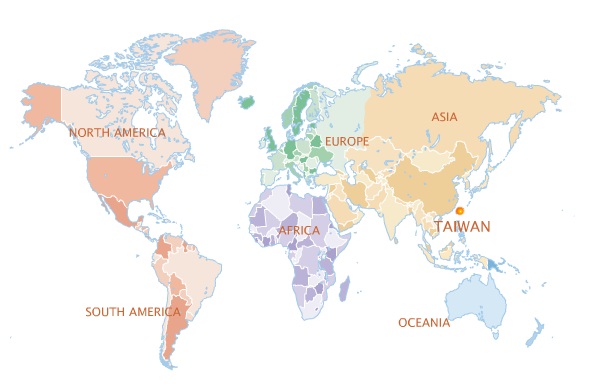
The Taiwan government has established 8 national parks and 13 national scenic areas to preserve Taiwan's best natural ecological environment and cultural sites. There are various ways to discover the beauty of Taiwan. For example, trekking in the magnificence of the cliffs at Taroko Gorge; taking a ride on the Alishan Forest Railway and experiencing the breathtaking sunrise and sea of clouds; hiking up to the summit of Northeast Asia's highest peak, Yu Mountain (Yushan). You can also soak up the sun in Kending (Kenting), Asia's version of Hawaii; stand at the edge of Sun Moon Lake; wander through the East Rift Valley; or visit the offshore islands of Kinmen and Penghu. It's fun in capital letters as well as an awesome journey of natural discovery! - History
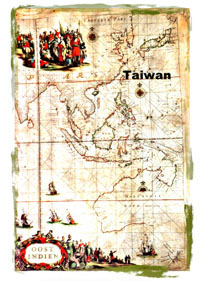 The Dutch occupied Taiwan in 1624 and remained as colonists for 37 years. The Spanish came and controlled northernmost Taiwan in 1626, but were driven out by the Dutch 16 years later in 1642. The Dutch were finally dislodged in 1661 by military forces from mainland led by the Ming dynasty loyalist Cheng Cheng-Kung (known to the West as Lord Koxinga). Koxinga used Taiwan as his base in the fight to overthrow the Ching dynasty and restore the Ming, but he failed. He cleared most of the obstacles for the settlement and contributed greatly to the island's development. Most of the settlement over the island was completed during the Ching Dynasty (1644-1911) when the government vastly expanded the areas of arable land and established schools, railroads, and highways. As a result of the Sino-Japanese War in 1895, the Treaty of Shimonoseki was signed and the Ching government ceded Taiwan and the Pescadores to the Japanese, under whose dominion the island remained in the next fifty years. Both were restored to Chinese rule at the end of the Second World War in 1945.
The Dutch occupied Taiwan in 1624 and remained as colonists for 37 years. The Spanish came and controlled northernmost Taiwan in 1626, but were driven out by the Dutch 16 years later in 1642. The Dutch were finally dislodged in 1661 by military forces from mainland led by the Ming dynasty loyalist Cheng Cheng-Kung (known to the West as Lord Koxinga). Koxinga used Taiwan as his base in the fight to overthrow the Ching dynasty and restore the Ming, but he failed. He cleared most of the obstacles for the settlement and contributed greatly to the island's development. Most of the settlement over the island was completed during the Ching Dynasty (1644-1911) when the government vastly expanded the areas of arable land and established schools, railroads, and highways. As a result of the Sino-Japanese War in 1895, the Treaty of Shimonoseki was signed and the Ching government ceded Taiwan and the Pescadores to the Japanese, under whose dominion the island remained in the next fifty years. Both were restored to Chinese rule at the end of the Second World War in 1945.
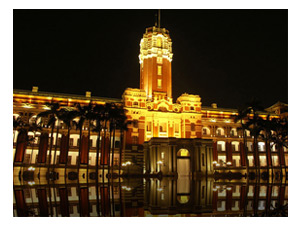 In 1949, the Nationalist Government of China retreated to Taiwan as a result of the civil war, and the evolution of Taiwan began to reflect a new tendency to develop independently, transforming herself gradually from a colony to a society governed by self-rule. Over the past sixty years, Taiwan rose from island status to world presence, Taiwan has dealt successfully with her difficult international situation, with her recent background of ethnic chaos and conflict, also with the basic conditions of impoverished natural resources and managed to achieve remarkable feats in democratization of the political process, in public education, and in economic construction. This process of development has become known throughout the world as an economic miracle.
In 1949, the Nationalist Government of China retreated to Taiwan as a result of the civil war, and the evolution of Taiwan began to reflect a new tendency to develop independently, transforming herself gradually from a colony to a society governed by self-rule. Over the past sixty years, Taiwan rose from island status to world presence, Taiwan has dealt successfully with her difficult international situation, with her recent background of ethnic chaos and conflict, also with the basic conditions of impoverished natural resources and managed to achieve remarkable feats in democratization of the political process, in public education, and in economic construction. This process of development has become known throughout the world as an economic miracle. - Religion
Taiwan practices freedom of religion, generously accepting foreign religious ideas while honoring traditional beliefs: even within the same family, it is common for different faiths to exist.
Traditional Chinese religions include Buddhism, Taoism, and folk beliefs. Taoism is indigenous to China, while Buddhism was introduced from India. Taoists and Buddhists originally worshipped separately in Taiwan, but during the period of Japanese occupation (1895-1945) Taoists were singled out for severe persecution and began worshipping their deities secretly in Buddhist temples. Lungshan Temple in Taipei.
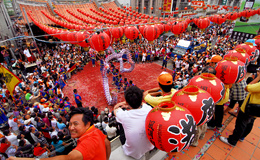 By the time Taiwan was returned to Chinese administration at the end of the Second World War, the two religions had blended together; while a few temples today are purely Buddhist, most Taiwanese continue worshipping a variety of Buddhist, Taoist, and folk deities in a single temple. The most famous example, however, is Confucius, who lived 2,500 years ago and was first enshrined by Emperor Yuan of the Western Han, who reigned 48-33 B.C. The Sage is honored today in many temples throughout Taiwan.
By the time Taiwan was returned to Chinese administration at the end of the Second World War, the two religions had blended together; while a few temples today are purely Buddhist, most Taiwanese continue worshipping a variety of Buddhist, Taoist, and folk deities in a single temple. The most famous example, however, is Confucius, who lived 2,500 years ago and was first enshrined by Emperor Yuan of the Western Han, who reigned 48-33 B.C. The Sage is honored today in many temples throughout Taiwan.
Christianity was brought to Taiwan in the early 17th century by Spanish and Dutch missionaries. A number of Presbyterian missions were founded in early times, including the Panhsi Church of Tataocheng (today known as Tachiao Church) in 1884; during the Japanese occupation period, the Chungshan Presbyterian Church, Chinan Church, and Chengchung Church were established.
Numerous other religions took hold in Taiwan in the atmosphere of religious freedom that followed retrocession; in addition to the Chinese religions and Christianity, Taiwan today also has followers of Bahaism, Islam, and Tienlichiao, among others.


